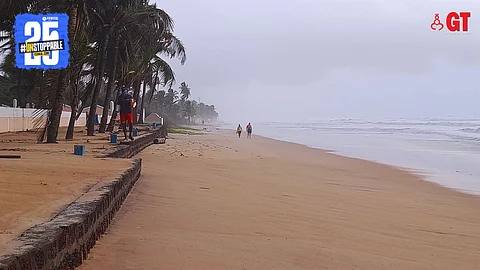

The tills have been jingling. The numbers of tourists visiting Goa have been constant and healthy but, those who were around in 2018 or before will sing paeans to those days.
“It’s no point looking back. The boom that we saw in the early mid-teens of 2000 is over. That was the time when tourism began to be defined as an industry. Unfortunately, we did not keep pace,” is how the bugle of those days now sounds.
Rich tourists, according to industry experts, have shifted to South Goa because the north is overcrowded, and the infrastructure has not kept pace with the surge in visitor numbers.
“It sometimes takes an hour or more just to reach from Candolim to Calangute. The roads are so crowded that driving is a problem, and it is only because infrastructure did not keep pace with the growth,” says a veteran of the business as he cherishes his caju feni.
Rich tourists don’t mind paying, but when they do, they expect service and it is the inability of the industry to provide value for money that has seen the financially empowered desert the north for the south.
“What does the north have to offer the rich tourists today?” asks a player, who once knew the call of the dices played by industry makers. “Everything is crowded, there are no restaurants that they can go to, no places to visit in peace and garbage all around. This, for a rich man, is financial duress,” says the former playmaker.
The south, today, is the fresh fruit bowl for high spenders. “It still is clean, and its beaches are still pristine. There are still many lush, green places in the south that one can travel past; the beaches are not littered and the road infrastructure is much better,” says Ramon, who oversees the operations of a travel agency.
From 2014 onwards, until just before the COVID-19 pandemic, tourism was booming with the influx of foreign tourists and the mat for this was laid through the concept of charter tourism.
Rich tourists don’t mind paying, but when they do, they expect service and it is the inability of the industry to provide value for money that has seen the financially empowered desert the north for the south.
That was a time when fleets of buses could be seen carrying foreigners from one temple site to another, from one church to another, and from one market to another.
Taxis whizzed from the Mapusa market to the Anjuna Flea market, and for those who loved nightlife, from Haystack in Arpora to the homes of locals, where traditional music could be heard playing.
“The charters changed the definition of tourism, and everyone turned red with glee with the returns. That was the time when everyone made money, and it was time and money well spent,” recollects Ramon with his friends.
Initially, say those who saw the first lights of industry success, it was Goa that was being sold, and that Goa was its people. “I do not know what it is, but the truth is that all who came here, liked us. That is the first bell and it rings for long,” says Austin whose homestay is now being refurbished.
“I have had guests who came for ten consecutive years before the pandemic. That was the time we did not need to sell rooms, but actually had to find rooms for the friends of our guests. That was the demand,” he recollects.
Taxis whizzed from the Mapusa market to the Anjuna Flea market, and for those who loved nightlife, from Haystack in Arpora to the homes of locals, where traditional music could be heard playing.
“We had a couple of people who cleaned the house, our cook prepared meals for us and the guests with the help of another assistant. Everything was so homey and yet so business-like,” remembers Austin.
The increase in the number of foreign tourists in the south was evident this year with the beaches, cities, walkways and even restaurants well patronised. The story was not the same in North Goa, with crowds, congestion and noise being the main irritants.
Industry stakeholders are confident that the flow of high-class tourists in the south will turn into a swell. Many believe that the north lost it whilst trying to make hay whilst the sun shone.
For many, backtracking is not the way to normalcy. Inventive tinkering could help.